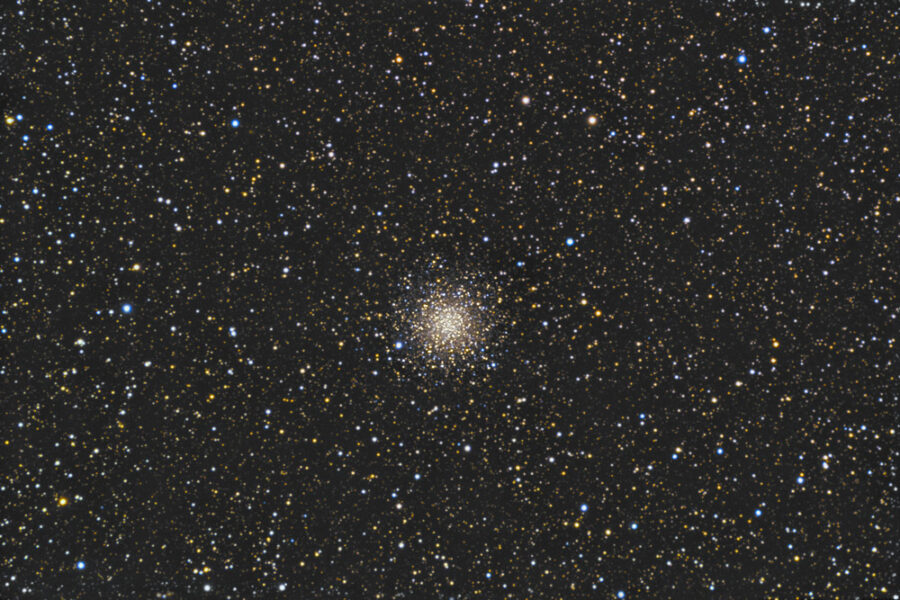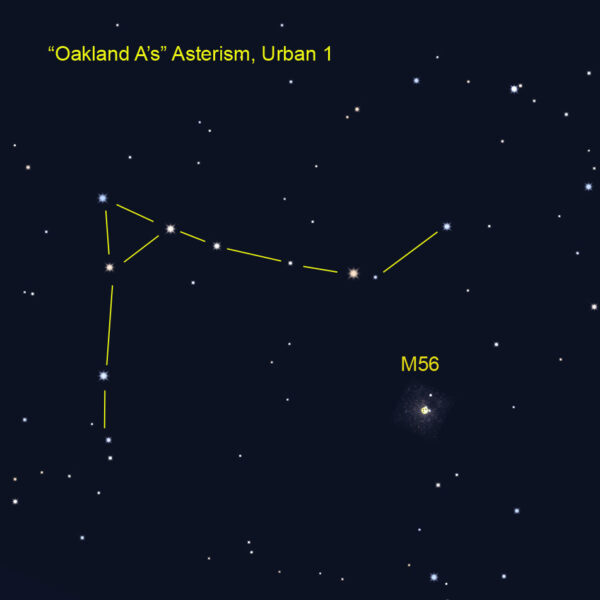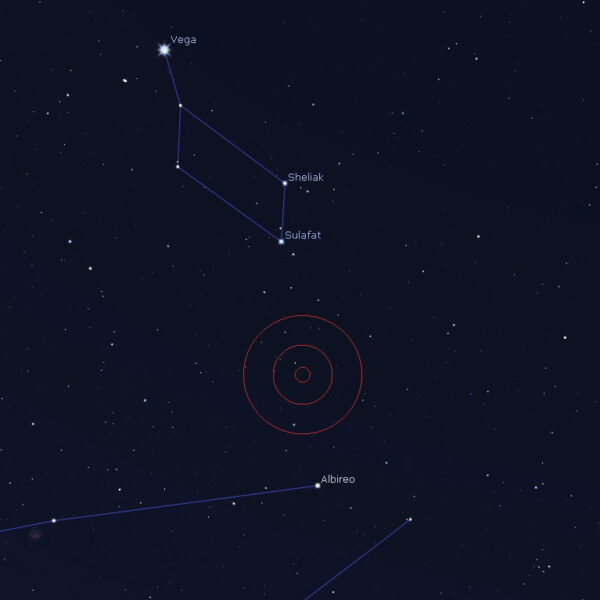The Overlooked Masterpiece of M56
“Small French Paintings” read the sign at the National Gallery of Art. The quiet exhibit, tucked back from the main hall, quickly became a favorite of mine. Away from all the bustle, these pieces had space to shine.

Rod Pommier / S&T Online Photo Gallery
If we imagine ourselves as visitors to a celestial art museum every time we observe, then here’s a “small French painting” for you: Messier 56. I affectionately call this globular cluster the “Dandelion,” its uniform haze resembling the flower gone to seed. While most summer observers head straight for the “Rembrandts” nearby, like the popular Hercules Globular Cluster (M13), a stop in this forgotten corner of Lyra rewards the patient observer with a delightfully subtle treat.
Street View
You’ll start tonight’s journey with Vega, the brightest star of Lyra, a blue-white dazzling high in the east on summer evenings. If your sky is dark enough, take a moment to appreciate the glittering “city lights” of the Milky Way nearby. You’re looking at our galaxy, which long ago captured another dwarf galaxy, and with it, M56.
Inside the doors
Switching to 10×50 binoculars, cruise down from Vega to the main body of the Lyre. Snag Sulafat (γ Lyrae) at the southwest corner of the constellation’s parallelogram. Pan down to Albireo, the favorite double star of summer and the beak or eye of Cygnus, the Swan. (You might be able to split it with binoculars if you can hold them really steady.)
Imagining the field as a clock face, move back up towards Sulafat so that Albireo exits the view at 5:00. Can you spot the “Oakland A’s” asterism entering at 12:00? I’m claiming it: Urban 1! In 10×50 glasses, M56 is nicely placed once the “A” is fully in view.
Just above the center of the field is a fuzzy 8.3-magnitude spot that seems out of place, as if someone had tried to erase a star with a cheap pencil. Home run! The 230,000 solar masses of M56 shine across almost 33 thousand light-years and would be even brighter if they weren't obscured by interstellar dust. This stellar metropolis is hurtling toward us at 145 kilometers per second (more than 324,000 mph).

Stellarium, with additions by author
Leaning In
To resolve individual stars in this cluster, you’ll need a telescope. Point your red dot finder just less than halfway up from Albireo to Sulafat.

Stellarium, with additions by author
Through my 4.25-inch f/10 home-built Dobsonian, M56 begins to take greater shape. Starting with low power, work your way up toward greater magnification. With a 40mm plossl (27×) eyepiece, the view agrees with Stephen James O’Meara’s “dirty snowball” description in Deep-Sky Companions: The Messier Objects. An unresolved globe of suns glimmers dimly from the deep, inviting more power. At 45×, the cluster lives up to its nickname of a dandelion taraxacum. And a 12.5mm Orthoscopic eyepiece (an essential ocular for anyone), which yields 90×, reveals hints of individual stars.
Making the Most of the Visit
Besides generating a bigger picture, greater magnification also darkens the background sky. The trick, especially with a small telescope, is to find the right balance between this contrast and brightness, as magnification also reduces an object’s surface brightness. Switching to 120× yields a dim and mushy view on my rig, so I go back to 90×. Each optical train and session is different, so it pays to try out different things.
I even noticed my left eye produced a slightly brighter image. You’ll also find that averted vision helps tease out individual stars.
Let me know if you can resolve this beauty into individual stars in your scope. And what color did you make it out to be? (I noticed a lovely blue gray through an 8-inch f/8 Dob at 100×, along with some nice resolution.) Experiment, and delight in the experience.
Enjoying the View
Charles Messier discovered M56 on January 19, 1779, the same night he found an actual comet. He may have been disappointed four nights later, when this fuzzball hadn’t moved. But its stillness earned it the 56th entry in Messier’s famed catalog, a listing of comet look-alikes.
Gazing through a modest instrument, now we know we're seeing a city of suns 85 light-years across. At 33,000 light-years away, the stars’ photons we observe tonight started their journey when vast sheets of ice covered Earth. But the stars themselves have been fusing hydrogen for 13.7 billion years, close to the age of the universe. Talk about “older than dirt!”
On Your Way Out
Perhaps M56 is just the first stop of your evening. Then you might also pay a visit to those nearby masterpieces — double star Albireo blazes in blue and orange in Cygnus, the Ring Nebula (M57) floats like a cosmic cheerio in the Milky Way near Lyra, and the M13 globular cluster stuns in Hercules.
But maybe you only have time for one target. This “small French painting” offers a quiet charm. Appreciating it from historical and theoretical aspects can add to our appreciation of this lovely sight. I hope you enjoy the view as much as I did!
 2
2








Comments
Joe Adlhoch
July 24, 2021 at 12:22 pm
Josh, I find it interesting that you mention Albireo as a blue-orange pair (Broncos fan, perhaps?). I do a lot of astronomy outreach and enjoy showing Albireo to the public. I find that, like the crazy black-blue/white-gold dress debate that was big on social media a few years ago (https://en.m.wikipedia.org/wiki/The_dress), lots of people see this double star differently. Some people see yellow or gold and blue (by far the most common response), some see orange and purple, some see white and red (!!), some see other combinations, and a few have said one of the stars looks green.
You must be logged in to post a comment.
JUrban
July 26, 2021 at 9:20 am
Hey Joe!
Ha, love the continuation of the sports metaphor! Now THIS is news to me, and something I'll surely incorporate into my outreach. I call it the "star wars double" sometimes, but have never polled folks. (And personally, next time I'm looking at it, I'll squint to see if I can see it as purple. That sounds like that would be fun.) Great tie in with "the dress" debate. I'll be borrowing that example to bring some pop culture into the science. Thanks for the tip!
You must be logged in to post a comment.
You must be logged in to post a comment.